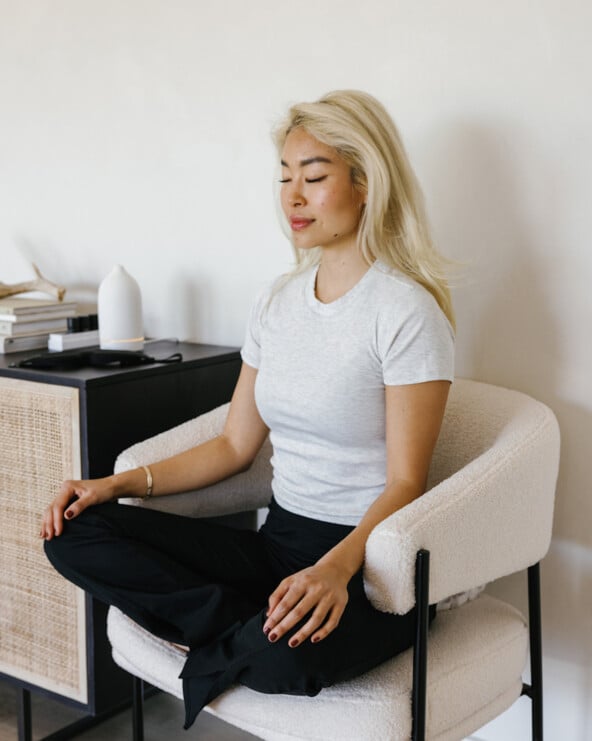In the midst of our always-on world—filled with endless notifications, packed schedules, and constant demands—it’s no wonder stress has become a near-universal experience. While self-care routines and stress-relief products can certainly help, there’s an even simpler and more profound tool that’s always within reach: your breath. Somatic breathwork, a practice that combines mindful breathing with heightened body awareness, offers a way to not only manage stress but also reconnect with yourself on a deeper level. By focusing on the sensations in your body and the rhythm of your breath, somatic breathwork helps shift your nervous system from a state of fight-or-flight to one of rest, relaxation, and healing.
Featured image from our interview with Remi Ishizuka by Michelle Nash.


At its core, somatic breathwork is about more than just calming your nerves—it’s a powerful practice for fostering emotional balance, physical well-being, and mental clarity. Rooted in ancient traditions yet backed by modern science, it invites us to tune into the body’s innate wisdom and create space for release and renewal.
Whether you’re new to breathwork or looking to deepen your practice, this guide will introduce you to the benefits of somatic breathwork and provide simple exercises to help you begin. Ready to breathe deeply and transform your well-being? Let’s get started.
What is somatic breathwork?
Somatic breathwork goes beyond simply controlling your breath—it invites you to fully tune into your body. By pairing mindful breathing with an awareness of physical sensations, somatic breathwork creates space to release tension, reduce stress, and reconnect with yourself on a deeper level.
Imagine it as a way to listen to what your body has been trying to tell you all along, using your breath as a bridge to understanding and healing.
What sets somatic breathwork apart from traditional techniques is its focus on the mind-body connection. While other methods may emphasize breath rhythms or patterns, this practice encourages you to notice the sensations that arise in your body as you breathe. This awareness helps process emotions, soothe stress, and restore balance to your nervous system. Over time, it gently shifts you from the fight-or-flight state triggered by stress into the calming “rest and digest” mode, where true relaxation and healing can take place.
Somatic Breathwork Benefits
The benefits of somatic breathwork extend far beyond stress relief. By bringing awareness to your breath and its connection to your body, this practice can help:
- regulate your emotions
- improve focus
- enhance your physical health by reducing inflammation and improving circulation.
Many practitioners also find that somatic breathwork deepens their ability to process unresolved emotions, offering a path to greater emotional resilience and clarity. In essence, somatic breathwork is a tool for holistic well-being, aligning the mind, body, and spirit.
3 Somatic Breathwork Exercises to Begin Practicing Today
Ready to explore the transformative power of somatic breathwork? These exercises are designed to be accessible and impactful, whether you’re new to the practice or looking to deepen your experience.
1. Body Scan Breathing
- Setup: Find a quiet space where you can sit or lie down comfortably.
- Instructions: Begin with slow, deep breaths, focusing on the rise and fall of your belly. With each exhale, direct your attention to a specific part of your body, starting at your feet and working your way up. Notice any tension or sensations in that area, and imagine releasing them with your breath.
- Benefits: This exercise helps you reconnect with your body, releasing stored tension and promoting relaxation.
2. Wave Breath
- Setup: Sit in a comfortable position with your feet flat on the ground.
- Instructions: Inhale deeply, imagining the breath traveling up from your feet, through your legs, and into your chest. As you exhale, picture the breath flowing back down the same path, grounding you. Repeat for 5–10 minutes.
- Benefits: Wave breath promotes a sense of groundedness and flow, making it especially helpful during moments of overwhelm.
3. Dynamic Release Breathing
- Setup: Lie down on a mat or soft surface with your knees bent and feet flat on the floor.
- Instructions: Take deep breaths into your belly and chest, allowing your body to move naturally with the rhythm of your breath. If emotions or sensations arise, let them flow without judgment. You can even incorporate gentle movements like rocking or stretching to deepen the release.
- Benefits: This exercise helps process and release stored emotions, leaving you feeling lighter and more centered.
How to Make Somatic Breathwork a Daily Habit
Consistency is key when it comes to reaping the benefits of somatic breathwork. Pair your practice with a daily ritual, such as your morning coffee or evening wind-down, to help it become second nature. Start small—just five minutes a day—and gradually increase the time as you grow more comfortable with the practice.
The Takeaway
Somatic breathwork offers a simple yet profound way to manage stress, reconnect with your body, and promote overall well-being. In a world that often pulls us away from ourselves, this practice invites us to slow down, tune in, and find peace within. Remember: your breath is always with you—use it to guide you back to calm whenever you need it most.





